The thin blue line is a colloquial term for police forces. The Thin Blue Line or Thin Blue Line may also refer to:

The Royal Canadian Mounted Police is the national police service of Canada. The RCMP is an agency of the Government of Canada; it also delivers police services under contract to 11 provinces and territories, over 150 municipalities, and 600 Indigenous communities. The RCMP is commonly known as the Mounties in English.
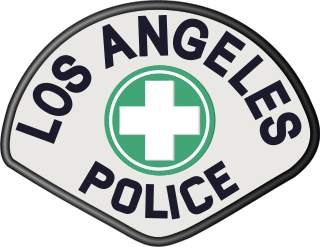
The Los Angeles Police Department (LAPD), officially known as the City of Los Angeles Police Department, is the primary law enforcement agency of Los Angeles, California, United States. With 8,832 officers and 3,000 civilian staff, it is the third-largest municipal police department in the United States, after the New York City Police Department and the Chicago Police Department.

Totenkopf is the German word for skull. The word is often used to denote a figurative, graphic or sculptural symbol, common in Western culture, consisting of the representation of a human skull- usually frontal, more rarely in profile with or without the mandible. In some cases, other human skeletal parts may be added, often including two crossed long bones (femurs) depicted below or behind the skull. The human skull is an internationally used symbol for death, the defiance of death, danger, or the dead, as well as piracy or toxicity.
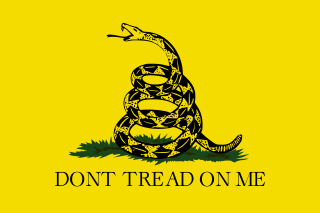
The Gadsden flag is a historical American flag with a yellow field depicting a timber rattlesnake coiled and ready to strike. Beneath the rattlesnake are the words "DONT TREAD ON ME". Some modern versions of the flag include an apostrophe.
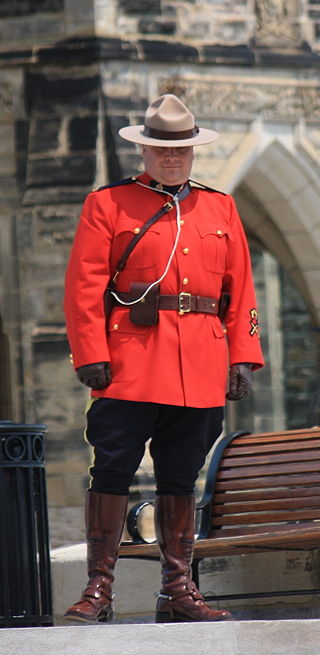
The Red Serge refers to the jacket of the dress uniform of the Royal Canadian Mounted Police. It consists of a scarlet British-style military pattern tunic, complete with a high-neck collar and blue breeches with yellow stripe identifying a cavalry history.

A peaked cap, peaked hat, service cap, barracks cover, or combination cap is a form of headgear worn by the armed forces of many nations, as well as many uniformed civilian organisations such as law enforcement agencies and fire departments. It derives its name from its short visor, or peak, which was historically made of polished leather but increasingly is made of a cheaper synthetic substitute.

The Peel Regional Police (PRP) provides policing services for Peel Region in Ontario, Canada. It is the second largest municipal police service in Ontario after the Toronto Police Service and third largest municipal force in Canada behind those of Toronto and Montreal, with 2,200 uniformed members and close to 875 support staff.
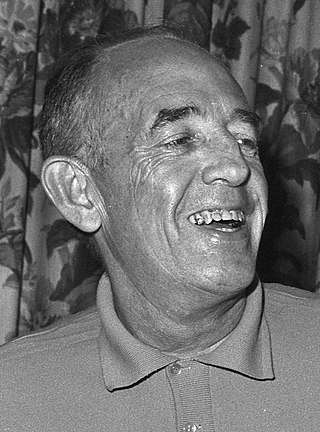
William Henry Parker III was an American law enforcement officer who was Chief of the Los Angeles Police Department (LAPD) from 1950 to 1966. To date, he is the longest-serving LAPD police chief. Parker has been called "Los Angeles' greatest and most controversial chief of police". The former headquarters of the LAPD, the Parker Center, was named after him. During his tenure, the LAPD was known for police brutality and racism; Parker himself was known for his "unambiguous racism".
Star Trek uniforms are costumes worn by actors portraying personnel of a fictitious Starfleet in various television series and films in the Star Trek science fiction franchise. During the various series, the costume design has often changed to represent different time periods and for reasons of appearance and comfort. Sometimes different styles were deliberately mixed to enhance the sense of time travel or alternative universes.

Gorget patches are an insignia in the form of paired patches of cloth or metal on the collar of a uniform (gorget), used in the military and civil service in some countries. Collar tabs sign the military rank, the rank of civil service, the military unit, the office (department) or the branch of the armed forces and the arm of service.
Auxiliary constables or reserve constables are unpaid citizens in Canada who volunteer their time and skills to a police force. They are uniformed, unarmed members who perform a similar role to their UK counterparts in the Special Constabulary. Their main function is to supplement the police force with additional manpower, with duties varying by appointment, geographical location and the needs of the specific detachment/department.

The Royal Air Force uniform is the standardised military dress worn by members of the Royal Air Force. The predominant colours of Royal Air Force uniforms are blue-grey and Wedgwood blue. Many Commonwealth air forces' uniforms are also based on the RAF pattern, but with nationality shoulder flashes. The Royal Air Force Air Cadets wear similar uniforms.
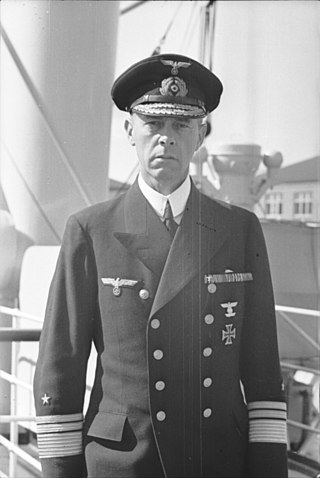
The Kriegsmarine was the navy of Nazi Germany prior to and during World War II. Kriegsmarine uniform design followed that of the preexisting Reichsmarine, itself based on that of the First World War Kaiserliche Marine. Kriegsmarine styles of uniform and insignia had many features in common with those of other European navies, all derived from the British Royal Navy of the 19th century, such as officers' frock coats, sleeve braid, and the "sailor suit" uniform for enlisted personnel and petty officers.
Police uniforms in the United States vary widely due to the nation's tradition of highly decentralized law enforcement. Over time, however, a number of general conventions and styles have become representative of American police fashion. Police officers wear uniforms to deter crime by establishing a visible presence while on patrol, to make themselves easily identifiable to non-police officers or to their colleagues who require assistance, and to quickly identify each other at crime scenes for ease of coordination.

Black Lives Matter (BLM) is a decentralized political and social movement that seeks to highlight racism, discrimination, and racial inequality experienced by black people and to promote anti-racism. Its primary concerns are police brutality and racially motivated violence against black people. The movement began in response to the killings of Trayvon Martin, Michael Brown, Eric Garner, and Rekia Boyd, among others. BLM and its related organizations typically advocate for various policy changes related to black liberation and criminal justice reform. While there are specific organizations that label themselves "Black Lives Matter", such as the Black Lives Matter Global Network Foundation, the overall movement is a decentralized network with no formal hierarchy. As of 2021, there are about 40 chapters in the United States and Canada. The slogan "Black Lives Matter" itself has not been trademarked by any group.

Blue Lives Matter is a countermovement in the United States that emerged in 2014 in direct opposition to the Black Lives Matter movement. It gained traction following the high-profile homicides of NYPD officers Rafael Ramos and Wenjian Liu in Brooklyn, New York. Supporters of Blue Lives Matter have called for crimes committed against police officers to be classified as hate crimes.

Melina Reimann Abdullah is an American academic and civic leader. She is the former chair of the department of Pan-African Studies at California State University, Los Angeles, and is a co-founder of the Los Angeles chapter of Black Lives Matter and Black Lives Matter Grassroots, for which she also serves as co-director.
Robert J. Kroll is an American former police officer and member of the Minneapolis Police Department. He was the president of the Police Officers Federation of Minneapolis, the police union for the police department, from 2015 to 2021. Over the course of his career, Kroll was involved in three officer-involved shootings, had 20 internal affairs complaints, and was the subject of several lawsuits. Kroll has been a longtime opponent to reforms of the police department, including calls to address racial bias within the force and reduce the number of people killed by police. Kroll has generated controversy on a number of occasions. In particular, his comments following the murder of George Floyd in May 2020 resulted in calls for his resignation, including from a number of unions, several former mayors of Minneapolis, and a former police chief. Kroll's comments were "Now is not the time rush to judgement and immediately condemn our officers. An in-depth investigation is underway. Our officers are fully cooperating. We must review all video. We must wait for the medical examiner’s report."

The murder of George Floyd on May 25, 2020, triggered a wave of protests throughout Tennessee in late May and early June 2020. These protests continued throughout the year.





































